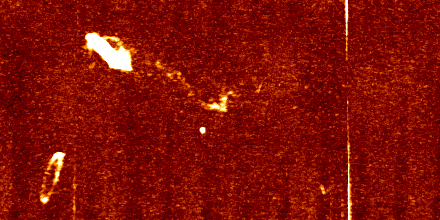The Tale Of VIRGOHI21
This is the most important GIF I've ever seen :
It's an animation (from Robert Minchin's website) showing the radio data set of a small part of the Virgo galaxy cluster. What it shows is a massive spiral galaxy (M99, NGC 4254) with a long tail of hydrogen that has a sharp "kink" near the end. That kink is not because the tail changes direction but because its kinematics – its motion – suddenly change. The blob in the centre of the image appears to be rotating, just like a normal dwarf galaxy, but no stars are visible there at all.
This was what my soon-to-be supervisor (Jon Davies) showed me at the PhD interview day. Simulations showed that a dark galaxy could interact with M99 in such a way that it could quite well reproduce the major characteristics of this system : the disturbed spiral arm of M99, the long HI tail, and of course the terminal kink and blob themselves. It was a really convincing system, and at the very least clearly something interesting was going on. I mean, a galaxy without any stars ! How neat is that ?
Since then, VIGOHI21 is no longer considered such a promising dark galaxy candidate. More sensitive (but lower resolution) observations showed that the blob wasn't at the end of the stream at all, but roughly in the middle of a much larger, fainter feature. That made the simulations rather more... suspect. And others had claimed that actually a perfectly normal but very fast-moving galaxy could do a rapid flyby of the spiral galaxy and this would draw out a similar tail and kink, without requiring a dark galaxy at all.
I myself was, for all sorts of reason, skeptical of this, especially given that the very sharp kink in the observations was not much like what was seen in the simulations. But some years later I ran my own simulations and found that indeed equally kinematically kinky objects – "fake" dark galaxies – could indeed be produced in just this way.
Does this mean we can rule out VIRGOHI21 as a dark galaxy ? Actually no... but we have to treat it with extreme caution. The fact that one explanation works does not automatically invalidate other explanations (I describe my favourite example of this in a blog post here); the original, dark-galaxy based simulations probably deserved a fuller investigation – but all the same, the more conservative explanation doesn't look to have any major difficulties here. So although it might still be a dark galaxy, there's no compelling reason to think that it actually is one.
You can read more about VIRGOHI21 (and other dark galaxy candidates) in my blog post here and the simulations I ran here. Robert Minchin, the discoverer, has his own post about this here – though he's a bit more skeptical than I am. I still think it's a weird system, whatever it is... most tidal encounters don't produce stuff that looks like this !
